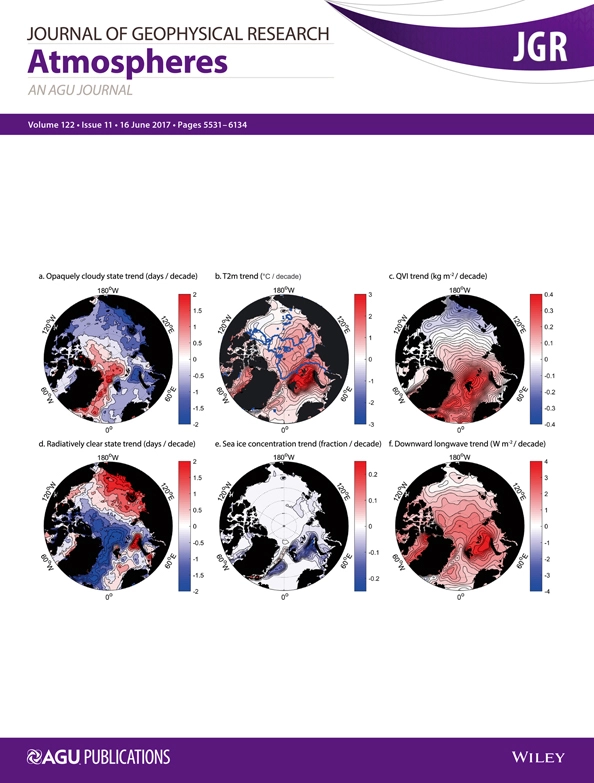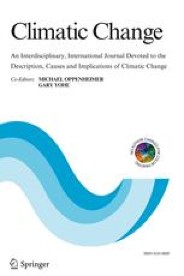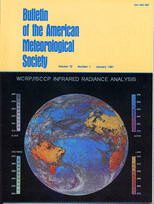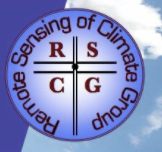Publications
2021
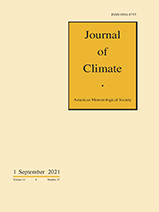
Tselioudis, G.; Rossow, W. B.; Jakob, C.; Remillard, J; Tropf, D.; Zhang, Y.
Evaluation of Clouds, Radiation, and Precipitation in CMIP6 Models Using Global Weather States Derived from ISCCP-H Cloud Property Data Journal Article
In: Journal of Climate, vol. 34, no. 17, pp. 7311-7324, 2021.
Abstract | Links | BibTeX | Tags: WEATHER STATE
@article{nokey,
title = {Evaluation of Clouds, Radiation, and Precipitation in CMIP6 Models Using Global Weather States Derived from ISCCP-H Cloud Property Data},
author = {G. Tselioudis and W.B. Rossow and C. Jakob and J Remillard and D. Tropf and Y. Zhang},
url = {https://www.williambrossow.com/wp-content/uploads/2022/09/2021_Tselioudisetal.pdf, Download file},
doi = {10.1175/JCLI-D-21-0076.1},
year = {2021},
date = {2021-09-01},
urldate = {2021-09-01},
journal = { Journal of Climate},
volume = {34},
number = {17},
pages = {7311-7324},
abstract = {A clustering methodology is applied to cloud optical depth (τ)\textendashcloud top pressure (TAU-PC) histograms from the new 1° resolution ISCCP-H dataset to derive an updated global weather state (WS) dataset. Then, TAU-PC histograms from current-climate CMIP6 model simulations are assigned to the ISCCP-H WSs along with their concurrent radiation and precipitation properties to evaluate model cloud, radiation, and precipitation properties in the context of the weather states. The new ISCCP-H analysis produces WSs that are very similar to those previously found in the lower-resolution ISCCP-D dataset. The main difference lies in the splitting of the ISCCP-D thin stratocumulus WS between the ISCCP-H shallow cumulus and stratocumulus WSs, which results in the reduction by one of the total WS number. The evaluation of the CMIP6 models against the ISCCP-H weather states shows that, in the ensemble mean, the models are producing an adequate representation of the frequency and geographical distribution of the WSs, with measurable improvements compared to the WSs derived for the CMIP5 ensemble. However, the frequency of shallow cumulus clouds continues to be underestimated, and, in some WSs the good agreement of the ensemble mean with observations comes from averaging models that significantly overpredict and underpredict the ISCCP-H WS frequency. In addition, significant biases exist in the internal cloud properties of the model WSs, such as the model underestimation of cloud fraction in middle-top clouds and secondarily in midlatitude storm and stratocumulus clouds, that result in an underestimation of cloud SW cooling in those regimes.},
keywords = {WEATHER STATE},
pubstate = {published},
tppubtype = {article}
}
2018
Mekonnen, Ademe; Rossow, William B
The interaction between deep convection and easterly wave activity over Africa: Convective transitions and mechanisms Journal Article
In: Mon. Weather Rev., vol. 146, no. 6, pp. 1945–1961, 2018.
Abstract | Links | BibTeX | Tags: WEATHER STATE
@article{Mekonnen2018-ux,
title = {The interaction between deep convection and easterly wave activity over Africa: Convective transitions and mechanisms},
author = {Ademe Mekonnen and William B Rossow},
url = {https://ams.confex.com/ams/98Annual/videogateway.cgi/id/42924?recordingid=42924\&uniqueid=Paper323311\&entry_password=null, Presentation
https://www.williambrossow.com/wp-content/uploads/2022/03/15200493-Monthly-Weather-Review-The-Interaction-between-Deep-Convection-and-Easterly-Wave-Activity-over-Africa_-Convective-Transitions-and-Mechanisms.pdf, Download file},
doi = {10.1175/mwr-d-17-0217.1},
year = {2018},
date = {2018-06-01},
urldate = {2018-06-01},
journal = {Mon. Weather Rev.},
volume = {146},
number = {6},
pages = {1945--1961},
publisher = {\"{A}merican Meteorological Society},
abstract = {Recent work using observational data from the International
Satellite Cloud Climatology Project (ISCCP) and reanalysis
products suggests that African easterly waves (AEWs) form in
association with a ``transition'' process from smaller and
scattered convection into larger and organized mesoscale
convective activity. However, the transition process is unclear
and how mesoscale convection initiates AEWs is not well
understood. Analysis based on 25 years of ISCCP and reanalysis
datasets show that increasing intradiurnal activity, atmospheric
instability, and specific humidity precede the development of
well-organized convection over the Ethiopian highlands.
Atmospheric instability favors a high frequency of scattered,
isolated convection to the east of the Ethiopian highlands,
first, followed by a continuing and large increase in
instability and increasing humidity, which supports
well-organized larger-scale convection. The timing of the
changes of thermodynamic variables shows that the dominant
transition process is scattered, with weakly organized
convection transitioning into the well-organized mesoscale
convection, and this initiates the AEWs. Slightly before the
mesoscale convection peaks over the Ethiopian highlands,
low-level moist westerlies, low- to midlevel wind shear, and
positive relative vorticity increase over the region. Evidence
shows that the large-scale and local environment enables the
scattered and less well-organized convection to merge and form
larger and well-organized convection. The dynamic processes
suggest that the dominant pathway for AEW initiation is
scattered convection transitioning to large and well-organized
convection over the Ethiopian highlands and this initiates AEWs
westward of the Ethiopian highlands.},
keywords = {WEATHER STATE},
pubstate = {published},
tppubtype = {article}
}
Satellite Cloud Climatology Project (ISCCP) and reanalysis
products suggests that African easterly waves (AEWs) form in
association with a ``transition'' process from smaller and
scattered convection into larger and organized mesoscale
convective activity. However, the transition process is unclear
and how mesoscale convection initiates AEWs is not well
understood. Analysis based on 25 years of ISCCP and reanalysis
datasets show that increasing intradiurnal activity, atmospheric
instability, and specific humidity precede the development of
well-organized convection over the Ethiopian highlands.
Atmospheric instability favors a high frequency of scattered,
isolated convection to the east of the Ethiopian highlands,
first, followed by a continuing and large increase in
instability and increasing humidity, which supports
well-organized larger-scale convection. The timing of the
changes of thermodynamic variables shows that the dominant
transition process is scattered, with weakly organized
convection transitioning into the well-organized mesoscale
convection, and this initiates the AEWs. Slightly before the
mesoscale convection peaks over the Ethiopian highlands,
low-level moist westerlies, low- to midlevel wind shear, and
positive relative vorticity increase over the region. Evidence
shows that the large-scale and local environment enables the
scattered and less well-organized convection to merge and form
larger and well-organized convection. The dynamic processes
suggest that the dominant pathway for AEW initiation is
scattered convection transitioning to large and well-organized
convection over the Ethiopian highlands and this initiates AEWs
westward of the Ethiopian highlands.
2017
Luo, Zhengzhao Johnny; Anderson, Ricardo C; Rossow, William B; Takahashi, Hanii
Tropical cloud and precipitation regimes as seen from near‐simultaneous TRMM, CloudSat, and CALIPSO observations and comparison with ISCCP Journal Article
In: J. Geophys. Res., vol. 122, no. 11, pp. 5988–6003, 2017.
Abstract | Links | BibTeX | Tags: PRECIPITATION, WATER VAPOR, WEATHER STATE
@article{Luo2017-bx,
title = {Tropical cloud and precipitation regimes as seen from near‐simultaneous TRMM, CloudSat, and CALIPSO observations and comparison with ISCCP},
author = {Zhengzhao Johnny Luo and Ricardo C Anderson and William B Rossow and Hanii Takahashi},
url = {https://www.williambrossow.com/wp-content/uploads/2022/03/JGR-Atmospheres-2017-Luo-Tropical-cloud-and-precipitation-regimes-as-seen-from-near‐simultaneous-TRMM-CloudSat-and.pdf, Download file},
doi = {10.1002/2017jd026569},
year = {2017},
date = {2017-06-01},
urldate = {2017-06-01},
journal = {J. Geophys. Res.},
volume = {122},
number = {11},
pages = {5988--6003},
publisher = {\"{A}merican Geophysical Union (AGU)},
abstract = {\"{A}lthough Tropical Rainfall Measuring Mission (TRMM) and
CloudSat/CALIPSO fly in different orbits, they frequently cross
each other so that for the period between 2006 and 2010, a total
of 15,986 intersect lines occurred within 20 min of each other
from 30°S to 30°N, providing a rare opportunity to study
tropical cloud and precipitation regimes and their internal
vertical structure from near‐simultaneous measurements by these
active sensors. A k‐means cluster analysis of TRMM and CloudSat
matchups identifies three tropical cloud and precipitation
regimes: the first two regimes correspond to, respectively,
organized deep convection with heavy rain and cirrus anvils with
moderate rain; the third regime is a convectively suppressed
regime that can be further divided into three subregimes, which
correspond to, respectively, stratocumulus clouds with drizzle,
cirrus overlying low clouds, and nonprecipitating cumulus.
Inclusion of CALIPSO data adds to the dynamic range of cloud
properties and identifies one more cluster; subcluster analysis
further identifies a thin, midlevel cloud regime associated with
tropical mountain ranges. The radar‐lidar cloud regimes are
compared with the International Satellite Cloud Climatology
Project (ISCCP) weather states (WSs) for the extended tropics.
Focus is placed on the four convectively active WSs, namely,
WS1--WS4. ISCCP WS1 and WS2 are found to be counterparts of
Regime 1 and Regime 2 in radar‐lidar observations, respectively.
ISCCP WS3 and WS4, which are mainly isolated convection and
broken, detached cirrus, do not have a strong association with
any individual radar and lidar regimes, a likely effect of the
different sampling strategies between ISCCP and active sensors
and patchy cloudiness of these WSs."},
keywords = {PRECIPITATION, WATER VAPOR, WEATHER STATE},
pubstate = {published},
tppubtype = {article}
}
CloudSat/CALIPSO fly in different orbits, they frequently cross
each other so that for the period between 2006 and 2010, a total
of 15,986 intersect lines occurred within 20 min of each other
from 30°S to 30°N, providing a rare opportunity to study
tropical cloud and precipitation regimes and their internal
vertical structure from near‐simultaneous measurements by these
active sensors. A k‐means cluster analysis of TRMM and CloudSat
matchups identifies three tropical cloud and precipitation
regimes: the first two regimes correspond to, respectively,
organized deep convection with heavy rain and cirrus anvils with
moderate rain; the third regime is a convectively suppressed
regime that can be further divided into three subregimes, which
correspond to, respectively, stratocumulus clouds with drizzle,
cirrus overlying low clouds, and nonprecipitating cumulus.
Inclusion of CALIPSO data adds to the dynamic range of cloud
properties and identifies one more cluster; subcluster analysis
further identifies a thin, midlevel cloud regime associated with
tropical mountain ranges. The radar‐lidar cloud regimes are
compared with the International Satellite Cloud Climatology
Project (ISCCP) weather states (WSs) for the extended tropics.
Focus is placed on the four convectively active WSs, namely,
WS1--WS4. ISCCP WS1 and WS2 are found to be counterparts of
Regime 1 and Regime 2 in radar‐lidar observations, respectively.
ISCCP WS3 and WS4, which are mainly isolated convection and
broken, detached cirrus, do not have a strong association with
any individual radar and lidar regimes, a likely effect of the
different sampling strategies between ISCCP and active sensors
and patchy cloudiness of these WSs."
2016
Rossow, W. B.; Zhang, Y. -C.; Tselioudis, G.
Atmospheric diabatic heating in different weather states and the general circulation Journal Article
In: J. Climate, vol. 29, no. 3, pp. 1059–1065, 2016.
Links | BibTeX | Tags: ENERGETICS, FEEDBACKS, WEATHER STATE
@article{ro01510v,
title = {Atmospheric diabatic heating in different weather states and the general circulation},
author = {W. B. Rossow and Y. -C. Zhang and G. Tselioudis},
url = {https://www.williambrossow.com/wp-content/uploads/2022/03/15200442-Journal-of-Climate-Atmospheric-Diabatic-Heating-in-Different-Weather-States-and-the-General-Circulation.pdf, Download file},
doi = {10.1175/JCLI-D-15-0760.1},
year = {2016},
date = {2016-01-01},
urldate = {2016-01-01},
journal = {J. Climate},
volume = {29},
number = {3},
pages = {1059--1065},
keywords = {ENERGETICS, FEEDBACKS, WEATHER STATE},
pubstate = {published},
tppubtype = {article}
}
2015
Tan, J.; Jakob, C.; Rossow, W. B.; Tselioudis, G.
Increases in tropical rainfall driven by changes in frequency of organized deep convection Journal Article
In: Nature, vol. 519, pp. 451–454, 2015.
Links | BibTeX | Tags: PRECIPITATION, WATER VAPOR, WEATHER STATE
@article{ta02100m,
title = {Increases in tropical rainfall driven by changes in frequency of organized deep convection},
author = {J. Tan and C. Jakob and W. B. Rossow and G. Tselioudis},
url = {https://www.williambrossow.com/wp-content/uploads/2022/09/2015_tanetal.nature14339.pdf, Download file},
doi = {10.1038/nature14339},
year = {2015},
date = {2015-01-01},
urldate = {2015-01-01},
journal = {Nature},
volume = {519},
pages = {451--454},
keywords = {PRECIPITATION, WATER VAPOR, WEATHER STATE},
pubstate = {published},
tppubtype = {article}
}
2013

Rossow, William B; Mekonnen, Ademe; Pearl, Cindy; Goncalves, Weber
Tropical precipitation extremes Journal Article
In: J. Clim., vol. 26, no. 4, pp. 1457–1466, 2013.
Abstract | Links | BibTeX | Tags: WEATHER STATE
@article{Rossow2013-sz,
title = {Tropical precipitation extremes},
author = {William B Rossow and Ademe Mekonnen and Cindy Pearl and Weber Goncalves},
url = {https://www.williambrossow.com/wp-content/uploads/2022/03/15200442-Journal-of-Climate-Tropical-Precipitation-Extremes.pdf, Download file},
doi = {10.1175/jcli-d-11-00725.1},
year = {2013},
date = {2013-02-01},
urldate = {2013-02-01},
journal = {J. Clim.},
volume = {26},
number = {4},
pages = {1457--1466},
publisher = {\"{A}merican Meteorological Society},
abstract = {\"{A}bstractClassifying tropical deep convective systems by the
mesoscale distribution of their cloud properties and sorting
matching precipitation measurements over an 11-yr period reveals
that the whole distribution of instantaneous precipitation
intensity and daily average accumulation rate is composed of (at
least) two separate distributions representing distinctly
different types of deep convection associated with different
meteorological conditions (the distributions of
non-deep-convective situations are also shown for completeness).
The two types of deep convection produce very different
precipitation intensities and occur with very different
frequencies of occurrence. Several previous studies have shown
that the interaction of the large-scale tropical circulation
with deep convection causes switching between these two types,
leading to a substantial increase of precipitation. In
particular, the extreme portion of the tropical precipitation
intensity distribution, above 2 mm h−1, is produced by 40% of
the larger, longer-lived mesoscale-organized type of convection
with only about 10% of the ordinary convection occurrences
producing such intensities. When average precipitation
accumulation rates are considered, essentially all of the values
above 2 mm h−1 are produced by the mesoscale systems. Yet
today's atmospheric models do not represent mesoscale-organized
deep convective systems that are generally larger than
current-day circulation model grid cell sizes but smaller than
the resolved dynamical scales and last longer than the typical
physics time steps. Thus, model-based arguments for how the
extreme part of the tropical precipitation distribution might
change in a warming climate are suspect."},
keywords = {WEATHER STATE},
pubstate = {published},
tppubtype = {article}
}
mesoscale distribution of their cloud properties and sorting
matching precipitation measurements over an 11-yr period reveals
that the whole distribution of instantaneous precipitation
intensity and daily average accumulation rate is composed of (at
least) two separate distributions representing distinctly
different types of deep convection associated with different
meteorological conditions (the distributions of
non-deep-convective situations are also shown for completeness).
The two types of deep convection produce very different
precipitation intensities and occur with very different
frequencies of occurrence. Several previous studies have shown
that the interaction of the large-scale tropical circulation
with deep convection causes switching between these two types,
leading to a substantial increase of precipitation. In
particular, the extreme portion of the tropical precipitation
intensity distribution, above 2 mm h−1, is produced by 40% of
the larger, longer-lived mesoscale-organized type of convection
with only about 10% of the ordinary convection occurrences
producing such intensities. When average precipitation
accumulation rates are considered, essentially all of the values
above 2 mm h−1 are produced by the mesoscale systems. Yet
today's atmospheric models do not represent mesoscale-organized
deep convective systems that are generally larger than
current-day circulation model grid cell sizes but smaller than
the resolved dynamical scales and last longer than the typical
physics time steps. Thus, model-based arguments for how the
extreme part of the tropical precipitation distribution might
change in a warming climate are suspect."

Lee, Dongmin; Oreopoulos, Lazaros; Huffman, George J; Rossow, William B; Kang, In-Sik
The precipitation characteristics of ISCCP tropical weather states Journal Article
In: J. Clim., vol. 26, no. 3, pp. 772–788, 2013.
Abstract | Links | BibTeX | Tags: PRECIPITATION, WATER VAPOR, WEATHER STATE
@article{Lee2013-mb,
title = {The precipitation characteristics of ISCCP tropical weather states},
author = {Dongmin Lee and Lazaros Oreopoulos and George J Huffman and William B Rossow and In-Sik Kang},
url = {https://www.williambrossow.com/wp-content/uploads/2022/03/15200442-Journal-of-Climate-The-Precipitation-Characteristics-of-ISCCP-Tropical-Weather-States.pdf, Download file},
doi = {10.1175/jcli-d-11-00718.1},
year = {2013},
date = {2013-02-01},
urldate = {2013-02-01},
journal = {J. Clim.},
volume = {26},
number = {3},
pages = {772--788},
publisher = {\"{A}merican Meteorological Society},
abstract = {\"{A}bstract The authors examine the daytime precipitation
characteristics of the International Satellite Cloud Climatology
Project (ISCCP) weather states in the extended tropics
(35°S--35°N) for a 10-yr period. The main precipitation dataset
used is the Tropical Rainfall Measuring Mission (TRMM)
Multisatellite Precipitation Analysis operational product 3B42
dataset, but Global Precipitation Climatology Project daily data
are also used for comparison. It is found that the most
convectively active ISCCP weather state (WS1), despite an
occurrence frequency below 10%, is the most dominant state with
regard to surface precipitation, producing both the largest mean
precipitation rates when present and the largest percent
contribution to the total precipitation of the tropics; yet,
even this weather state appears to not precipitate about half
the time, although this may be to some extent an artifact of
detection and spatiotemporal matching limitations of the
precipitation dataset. WS1 exhibits a modest annual cycle of the
domain-average precipitation rate, but notable seasonal shifts
in its geographic distribution. The precipitation rates of the
other weather states appear to be stronger when occurring before
or after WS1. The precipitation rates of the various weather
states are different between ocean and land, with WS1 producing
higher daytime rates on average over ocean than land, likely
because of the larger size and more persistent nature of oceanic
WS1s. The results of this study, in addition to advancing the
understanding of tropical hydrology, can serve as higher-order
diagnostics for evaluating the realism of tropical precipitation
distributions in large-scale models."},
keywords = {PRECIPITATION, WATER VAPOR, WEATHER STATE},
pubstate = {published},
tppubtype = {article}
}
characteristics of the International Satellite Cloud Climatology
Project (ISCCP) weather states in the extended tropics
(35°S--35°N) for a 10-yr period. The main precipitation dataset
used is the Tropical Rainfall Measuring Mission (TRMM)
Multisatellite Precipitation Analysis operational product 3B42
dataset, but Global Precipitation Climatology Project daily data
are also used for comparison. It is found that the most
convectively active ISCCP weather state (WS1), despite an
occurrence frequency below 10%, is the most dominant state with
regard to surface precipitation, producing both the largest mean
precipitation rates when present and the largest percent
contribution to the total precipitation of the tropics; yet,
even this weather state appears to not precipitate about half
the time, although this may be to some extent an artifact of
detection and spatiotemporal matching limitations of the
precipitation dataset. WS1 exhibits a modest annual cycle of the
domain-average precipitation rate, but notable seasonal shifts
in its geographic distribution. The precipitation rates of the
other weather states appear to be stronger when occurring before
or after WS1. The precipitation rates of the various weather
states are different between ocean and land, with WS1 producing
higher daytime rates on average over ocean than land, likely
because of the larger size and more persistent nature of oceanic
WS1s. The results of this study, in addition to advancing the
understanding of tropical hydrology, can serve as higher-order
diagnostics for evaluating the realism of tropical precipitation
distributions in large-scale models."

Tselioudis, G.; Rossow, W. B.; Zhang, Y. -C.; Konsta, D.
Global weather states and their properties from passive and active satellite cloud retrievals Journal Article
In: J. Climate, vol. 26, pp. 7734–7746, 2013.
Links | BibTeX | Tags: WEATHER STATE
@article{ts00300k,
title = {Global weather states and their properties from passive and active satellite cloud retrievals},
author = {G. Tselioudis and W. B. Rossow and Y. -C. Zhang and D. Konsta},
url = {https://www.williambrossow.com/wp-content/uploads/2022/03/2013_Tselioudis_ts00300k.pdf, Download file},
doi = {10.1175/JCLI-D-13-00024.1},
year = {2013},
date = {2013-01-01},
urldate = {2013-01-01},
journal = {J. Climate},
volume = {26},
pages = {7734--7746},
keywords = {WEATHER STATE},
pubstate = {published},
tppubtype = {article}
}
2011

Mekonnen, Ademe; Rossow, William B
The interaction between deep convection and easterly waves over tropical North Africa: A weather state perspective Journal Article
In: J. Clim., vol. 24, no. 16, pp. 4276–4294, 2011.
Abstract | Links | BibTeX | Tags: WEATHER STATE
@article{Mekonnen2011-vi,
title = {The interaction between deep convection and easterly waves over tropical North Africa: A weather state perspective},
author = {Ademe Mekonnen and William B Rossow},
url = {https://www.williambrossow.com/wp-content/uploads/2022/04/15200442-Journal-of-Climate-The-Interaction-Between-Deep-Convection-and-Easterly-Waves-over-Tropical-North-Africa_-A-Weather-State-Perspective.pdf, Download file},
doi = {10.1175/2011jcli3900.1.},
year = {2011},
date = {2011-08-01},
urldate = {2011-08-01},
journal = {J. Clim.},
volume = {24},
number = {16},
pages = {4276--4294},
publisher = {\"{A}merican Meteorological Society},
abstract = {\"{A}bstract The interaction between deep convection and easterly
waves over tropical North Africa is studied using a weather
state (WS) dataset from the International Cloud Climatology
Project (ISCCP) and reanalysis products from the European Centre
for Medium-Range Weather Forecast, as well as radiative fluxes
from ISCCP and a precipitation dataset from the Global
Precipitation Climatology Project. Composite analysis based on
21 yr of data shows that stronger latent and radiative heating
of the atmosphere are associated with stronger, more organized,
convective activity than with weaker, less organized, convective
activity, implying that any transition from less to more
organized and stronger convection increases atmospheric heating.
Regression composites based on a meridional wind predictor
reveal coherent westward propagation of WS and large-scale wind
anomalies from the Arabian Sea into East Africa and through West
Africa. The analysis shows that enhanced, but unorganized,
convective activity, which develops over the Arabian Sea and
western Indian Ocean, switches to organized convective activity
prior to the appearance of the African easterly wave (AEW)
signature. The results also suggest that low-level moisture flux
convergence and the upper-tropospheric wind divergence
facilitate this change. Thus, the upper-level easterly waves,
propagating into East Africa from the Indian Ocean, enhance one
form of convection, which interacts with the Ethiopian highlands
to trigger another, more organized, form of convection that, in
turn, initiates the low-level AEWs."},
keywords = {WEATHER STATE},
pubstate = {published},
tppubtype = {article}
}
waves over tropical North Africa is studied using a weather
state (WS) dataset from the International Cloud Climatology
Project (ISCCP) and reanalysis products from the European Centre
for Medium-Range Weather Forecast, as well as radiative fluxes
from ISCCP and a precipitation dataset from the Global
Precipitation Climatology Project. Composite analysis based on
21 yr of data shows that stronger latent and radiative heating
of the atmosphere are associated with stronger, more organized,
convective activity than with weaker, less organized, convective
activity, implying that any transition from less to more
organized and stronger convection increases atmospheric heating.
Regression composites based on a meridional wind predictor
reveal coherent westward propagation of WS and large-scale wind
anomalies from the Arabian Sea into East Africa and through West
Africa. The analysis shows that enhanced, but unorganized,
convective activity, which develops over the Arabian Sea and
western Indian Ocean, switches to organized convective activity
prior to the appearance of the African easterly wave (AEW)
signature. The results also suggest that low-level moisture flux
convergence and the upper-tropospheric wind divergence
facilitate this change. Thus, the upper-level easterly waves,
propagating into East Africa from the Indian Ocean, enhance one
form of convection, which interacts with the Ethiopian highlands
to trigger another, more organized, form of convection that, in
turn, initiates the low-level AEWs."
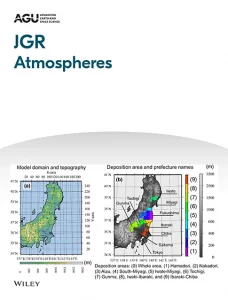
Oreopoulos, Lazaros; Rossow, William B
The cloud radiative effects of International Satellite Cloud Climatology Project weather states Journal Article
In: J. Geophys. Res., vol. 116, no. D12, 2011.
Links | BibTeX | Tags: RADIATION EXCHANGES, WEATHER STATE
@article{Oreopoulos2011-dw,
title = {The cloud radiative effects of International Satellite Cloud Climatology Project weather states},
author = {Lazaros Oreopoulos and William B Rossow},
url = {https://www.williambrossow.com/wp-content/uploads/2022/09/2011_OreopoulosRossow_JD015472.pdf, Download file},
doi = {10.1029/2010JD015472},
year = {2011},
date = {2011-06-01},
urldate = {2011-06-01},
journal = {J. Geophys. Res.},
volume = {116},
number = {D12},
publisher = {\"{A}merican Geophysical Union (AGU)},
keywords = {RADIATION EXCHANGES, WEATHER STATE},
pubstate = {published},
tppubtype = {article}
}

Tselioudis, George; Rossow, William B
Time scales of variability of the tropical atmosphere derived from cloud-defined weather states Journal Article
In: J. Clim., vol. 24, no. 3, pp. 602–608, 2011.
Abstract | Links | BibTeX | Tags: ANALYSIS, MODELS, WEATHER STATE
@article{Tselioudis2011-ty,
title = {Time scales of variability of the tropical atmosphere derived from cloud-defined weather states},
author = {George Tselioudis and William B Rossow},
url = {https://www.williambrossow.com/wp-content/uploads/2022/04/2011_Tselioudis_ts07200r.pdf, Download file},
year = {2011},
date = {2011-02-01},
urldate = {2011-02-01},
journal = {J. Clim.},
volume = {24},
number = {3},
pages = {602--608},
publisher = {\"{A}merican Meteorological Society},
abstract = { The recent analysis of Rossow et al. used a clustering
technique to derive six tropical weather states (WS) based on
mesoscale cloud-type patterns and documented the spatial
distribution of those WS and the modes of variability of the
convective WS in the tropical western Pacific. In this study,
the global tropics are separated into 30° $times$ 30° regions,
and a clustering algorithm is applied to the regional WS
frequency distributions to derive the dominant modes of weather
state variability (or the climate state variability) in each
region. The results show that the whole tropical atmosphere
oscillates between a convectively active and a convectively
suppressed regime with the exception of the eastern parts of the
two ocean basins, where the oscillation is between a
stratocumulus and a trade cumulus regime. The dominant mode of
both those oscillations is the seasonal cycle with the exception
of the eastern Indian and western--central Pacific region, where
El Ni~no frequencies dominate. The transitions between the
convectively active and suppressed regimes produce longwave (LW)
and shortwave (SW) top-of-atmosphere (TOA) radiative differences
that are of opposite sign and of similar magnitude, being of
order 20--30 W m−2 over ocean and 10--20 W m−2 over land and
thus producing an overall balance in the TOA radiative budget.
The precipitation differences between the convectively active
and suppressed regimes are found to be of order 2.5--3 mm day−1
over ocean and 1--2.4 mm day−1 over land. Finally, the
transitions between the stratocumulus and shallow cumulus
regimes produce noticeable TOA SW differences of order 10--20 W
m−2 and very small TOA LW and precipitation differences. The
potential climate feedback implications of the regime radiation
and precipitation differences are discussed."},
keywords = {ANALYSIS, MODELS, WEATHER STATE},
pubstate = {published},
tppubtype = {article}
}
technique to derive six tropical weather states (WS) based on
mesoscale cloud-type patterns and documented the spatial
distribution of those WS and the modes of variability of the
convective WS in the tropical western Pacific. In this study,
the global tropics are separated into 30° $times$ 30° regions,
and a clustering algorithm is applied to the regional WS
frequency distributions to derive the dominant modes of weather
state variability (or the climate state variability) in each
region. The results show that the whole tropical atmosphere
oscillates between a convectively active and a convectively
suppressed regime with the exception of the eastern parts of the
two ocean basins, where the oscillation is between a
stratocumulus and a trade cumulus regime. The dominant mode of
both those oscillations is the seasonal cycle with the exception
of the eastern Indian and western--central Pacific region, where
El Ni~no frequencies dominate. The transitions between the
convectively active and suppressed regimes produce longwave (LW)
and shortwave (SW) top-of-atmosphere (TOA) radiative differences
that are of opposite sign and of similar magnitude, being of
order 20--30 W m−2 over ocean and 10--20 W m−2 over land and
thus producing an overall balance in the TOA radiative budget.
The precipitation differences between the convectively active
and suppressed regimes are found to be of order 2.5--3 mm day−1
over ocean and 1--2.4 mm day−1 over land. Finally, the
transitions between the stratocumulus and shallow cumulus
regimes produce noticeable TOA SW differences of order 10--20 W
m−2 and very small TOA LW and precipitation differences. The
potential climate feedback implications of the regime radiation
and precipitation differences are discussed."

Haynes, J. M.; Jakob, C.; Rossow, W. B.; Tselioudis, G.; Brown, J.
Major characteristics of Southern Ocean cloud regimes and their effects on the energy budget Journal Article
In: J. Climate, vol. 24, pp. 5061–5080, 2011.
Links | BibTeX | Tags: WEATHER STATE
@article{ha04510h,
title = {Major characteristics of Southern Ocean cloud regimes and their effects on the energy budget},
author = {J. M. Haynes and C. Jakob and W. B. Rossow and G. Tselioudis and J. Brown},
url = {https://www.williambrossow.com/wp-content/uploads/2022/04/2011_Haynes_ha04510h.pdf, Download file},
doi = {10.1175/2011JCLI4052.1},
year = {2011},
date = {2011-01-01},
urldate = {2011-01-01},
journal = {J. Climate},
volume = {24},
pages = {5061--5080},
keywords = {WEATHER STATE},
pubstate = {published},
tppubtype = {article}
}
2010

Marchand, R.; Ackerman, T.; Smythe, M.; Rossow, W. B.
A review of cloud top height and optical depth histograms from MISR, ISCCP and MODIS Journal Article
In: J. Geophys. Res., vol. 115, pp. D16206, 2010.
Links | BibTeX | Tags: CLOUD PROPERTIES, WEATHER STATE
@article{ma04700p,
title = {A review of cloud top height and optical depth histograms from MISR, ISCCP and MODIS},
author = {R. Marchand and T. Ackerman and M. Smythe and W. B. Rossow},
url = {https://www.williambrossow.com/wp-content/uploads/2022/05/Journal-of-Geophysical-Research-Atmospheres-2010-Marchand-A-review-of-cloud-top-height-and-optical-depth-histograms.pdf, Download file },
doi = {10.1029/2009JD013422},
year = {2010},
date = {2010-01-01},
urldate = {2010-01-01},
journal = {J. Geophys. Res.},
volume = {115},
pages = {D16206},
keywords = {CLOUD PROPERTIES, WEATHER STATE},
pubstate = {published},
tppubtype = {article}
}

Tselioudis, G.; Tromeur, E.; Rossow, W. B.; Zerefos, C. S.
Decadal changes in tropical convection suggest effects on stratospheric water vapor Journal Article
In: Geophys. Res. Lett., vol. 37, pp. L14806, 2010.
Links | BibTeX | Tags: WEATHER STATE
@article{ts06200v,
title = {Decadal changes in tropical convection suggest effects on stratospheric water vapor},
author = {G. Tselioudis and E. Tromeur and W. B. Rossow and C. S. Zerefos},
url = {https://www.williambrossow.com/wp-content/uploads/2022/05/2010_Tselioudis_ts06200v.pdf, Download file},
doi = {10.1029/2010GL044092},
year = {2010},
date = {2010-01-01},
urldate = {2010-01-01},
journal = {Geophys. Res. Lett.},
volume = {37},
pages = {L14806},
keywords = {WEATHER STATE},
pubstate = {published},
tppubtype = {article}
}

Tromeur, E.; Rossow, W. B.
Interaction of tropical deep convection with the large-scale circulation in the MJO Journal Article
In: J. Climate, vol. 23, pp. 1837–1853, 2010.
Links | BibTeX | Tags: WEATHER STATE
@article{tr07100z,
title = {Interaction of tropical deep convection with the large-scale circulation in the MJO},
author = {E. Tromeur and W. B. Rossow},
url = {https://www.williambrossow.com/wp-content/uploads/2022/05/2010_Tromeur_tr07100z.pdf, Download file},
doi = {10.1175/202009JCLI3240.1},
year = {2010},
date = {2010-01-01},
urldate = {2010-01-01},
journal = {J. Climate},
volume = {23},
pages = {1837--1853},
keywords = {WEATHER STATE},
pubstate = {published},
tppubtype = {article}
}
2005
Rossow, W. B.; Tselioudis, G.; Polak, A.; Jakob, C.
Tropical climate described as a distribution of weather states indicated by distinct mesoscale cloud property mixtures Journal Article
In: Geophys. Res. Lett., vol. 32, pp. L21812, 2005.
Links | BibTeX | Tags: ANALYSIS, MODELS, WEATHER STATE
@article{ro09700z,
title = {Tropical climate described as a distribution of weather states indicated by distinct mesoscale cloud property mixtures},
author = {W. B. Rossow and G. Tselioudis and A. Polak and C. Jakob},
url = {https://www.williambrossow.com/wp-content/uploads/2022/06/2005_Rossow_ro09700z.pdf, Download file},
doi = {10.1029/2005GL024584},
year = {2005},
date = {2005-01-01},
urldate = {2005-01-01},
journal = {Geophys. Res. Lett.},
volume = {32},
pages = {L21812},
keywords = {ANALYSIS, MODELS, WEATHER STATE},
pubstate = {published},
tppubtype = {article}
}
2001
Hahn, C. J.; Rossow, W. B.; Warren, S. G.
ISCCP cloud properties associated with standard cloud types identified in individual surface observations Journal Article
In: J. Climate, vol. 14, pp. 11–28, 2001.
Links | BibTeX | Tags: CLOUD PROPERTIES, ISCCP, WEATHER STATE
@article{ha07200r,
title = {ISCCP cloud properties associated with standard cloud types identified in individual surface observations},
author = {C. J. Hahn and W. B. Rossow and S. G. Warren},
url = {https://www.williambrossow.com/wp-content/uploads/2022/06/2001_Hahn_ha07200r.pdf, Download file},
doi = {10.1175/1520-0442(2001)014%3C0011%3AICPAWS%3E2.0.CO;2},
year = {2001},
date = {2001-01-01},
urldate = {2001-01-01},
journal = {J. Climate},
volume = {14},
pages = {11--28},
keywords = {CLOUD PROPERTIES, ISCCP, WEATHER STATE},
pubstate = {published},
tppubtype = {article}
}
2000
Tselioudis, G.; Zhang, Y. -C.; Rossow, W. R.
Cloud and radiation variations associated with northern midlatitude low and high sea level pressure regimes Journal Article
In: J. Climate, vol. 13, pp. 312–327, 2000.
Links | BibTeX | Tags: CLOUD PROPERTIES, RADIATION EXCHANGES, WEATHER STATE
@article{ts02000x,
title = {Cloud and radiation variations associated with northern midlatitude low and high sea level pressure regimes},
author = {G. Tselioudis and Y. -C. Zhang and W. R. Rossow},
url = {https://www.williambrossow.com/wp-content/uploads/2022/07/2000_Tselioudis_ts02000x.pdf, Download file},
doi = {10.1175/1520-0442(2000)013%3C0312%3ACARVAW%3E2.0.CO;2},
year = {2000},
date = {2000-01-01},
urldate = {2000-01-01},
journal = {J. Climate},
volume = {13},
pages = {312--327},
keywords = {CLOUD PROPERTIES, RADIATION EXCHANGES, WEATHER STATE},
pubstate = {published},
tppubtype = {article}
}
1995
Rossow, W. B.; Cairns, B.
Monitoring changes of clouds Journal Article
In: Climatic Change, vol. 31, pp. 175–217, 1995.
Links | BibTeX | Tags: ANALYSIS, CLOUD PROPERTIES, MODELS, WEATHER STATE
@article{ro07000g,
title = {Monitoring changes of clouds},
author = {W. B. Rossow and B. Cairns},
url = {https://www.williambrossow.com/wp-content/uploads/2022/08/1995_Rossow_ro07000g.pdf, Download file},
doi = {10.1007/BF01095151},
year = {1995},
date = {1995-01-01},
urldate = {1995-01-01},
journal = {Climatic Change},
volume = {31},
pages = {175--217},
keywords = {ANALYSIS, CLOUD PROPERTIES, MODELS, WEATHER STATE},
pubstate = {published},
tppubtype = {article}
}
1991
Rossow, W. B.; Schiffer, R. A.
ISCCP cloud data products Journal Article
In: Bull. Amer. Meteorol. Soc., vol. 71, pp. 2–20, 1991.
Links | BibTeX | Tags: ISCCP, WEATHER STATE
@article{ro05000n,
title = {ISCCP cloud data products},
author = {W. B. Rossow and R. A. Schiffer},
url = {https://www.williambrossow.com/wp-content/uploads/2022/08/1991_Rossow_ro05000n.pdf, Download file},
year = {1991},
date = {1991-01-01},
urldate = {1991-01-01},
journal = {Bull. Amer. Meteorol. Soc.},
volume = {71},
pages = {2--20},
keywords = {ISCCP, WEATHER STATE},
pubstate = {published},
tppubtype = {article}
}
Seze, G.; Rossow, W. B.
Time-cumulated visible and infrared radiance histograms used as descriptors of surface and cloud variations Journal Article
In: Int. J. Remote Sens., vol. 12, pp. 877–920, 1991.
Links | BibTeX | Tags: ANALYSIS, MODELS, WEATHER STATE
@article{se06000k,
title = {Time-cumulated visible and infrared radiance histograms used as descriptors of surface and cloud variations},
author = {G. Seze and W. B. Rossow},
url = {https://www.williambrossow.com/wp-content/uploads/2022/08/1991_Seze_Rossow_1.pdf, Download file},
doi = {10.1080/01431169108929702},
year = {1991},
date = {1991-01-01},
urldate = {1991-01-01},
journal = {Int. J. Remote Sens.},
volume = {12},
pages = {877--920},
keywords = {ANALYSIS, MODELS, WEATHER STATE},
pubstate = {published},
tppubtype = {article}
}

